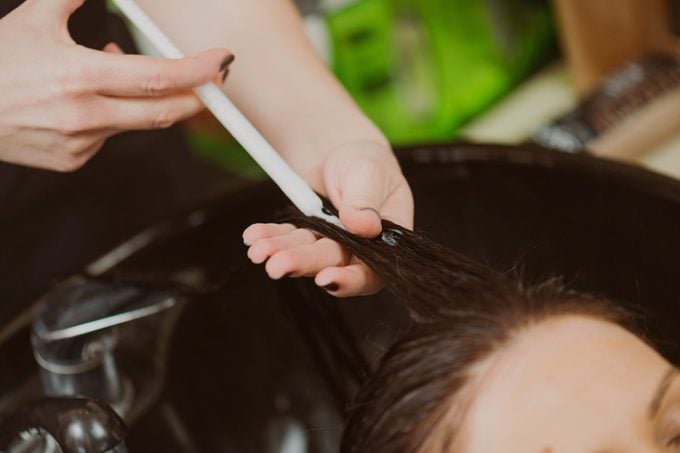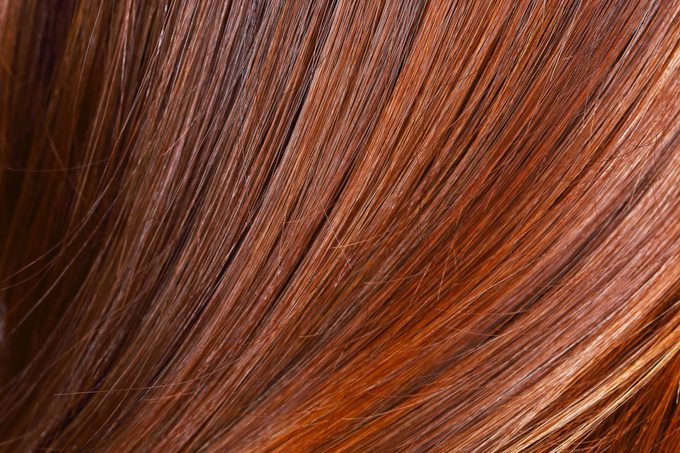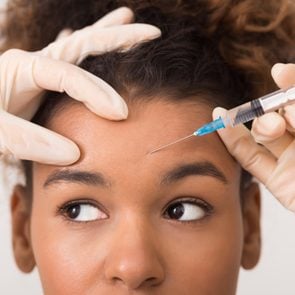Yes, ‘Hair Botox’ Exists, but It’s Not What It Sounds Like
Updated: Dec. 02, 2021
When you hear 'hair Botox,' you may wonder if our youth-obsessed culture has gone a step too far in the search for eternal youth. Here is a look at this all-natural approach to damaged, stressed hair.
What is hair Botox?
First of all, it’s not what you think.
Hair Botox, unlike its wrinkle-smoothing namesake, is not an injection and does not include botulinum toxin. It’s a non-chemical, deep conditioning treatment that coats the hair’s surface and helps tame frizz and flyaways.
The name stems from how the product works. The real Botox relaxes muscles, filling in lines and smoothing skin on your face. Similarly (but in a different way), hair Botox plumps up hair strands, eases kinks, and gently smooths tresses.
For Atlanta-based salon owner Daniel Mason Jones, hair Botox is a “game-changer” for clients looking for silky-smooth hair beyond just the weekend.
“Hair Botox is a custom curated treatment for the individual’s particular hair needs,” says Mason Jones, who serves as the creative director for Muse Salon and Spa.
“There are several different types of treatment that can be used depending on the severity of [the] damage.”
Both treatments are temporary fixes requiring a long-term commitment to keep up appearances. So here’s what you need to know before committing to hair Botox, including how it works, much it costs, and how it differs from a keratin hair treatment.

Ingredient list for hair Botox
Despite the name, hair Botox does not contain botulinum toxin, the main ingredient of Botox. Instead, stylists use a blend of primarily natural oils and extracts, along with healthy doses of hydrating and moisturizing substances.
Mason Jones says while brands and blends vary, he recommends looking for a treatment that includes amino acids, collagen, hyaluronic acid, vitamin B5, and glycomine, along with natural oils.
The benefits of hair Botox
If your crowning glory is losing the battle against aging, heat, and chemicals, a hair Botox treatment may be your beauty rescue.
Signs you made want this treatment include:
- split ends/breakages
- limp or flat locks
- frizzy hair that resists straightening
- damaged hair from dyes or overprocessing
- thinning hair
Mason Jones says basically anyone who routinely uses heat tools like curling irons, straighteners, and blow dryers, or who lightens their hair with balayage or highlights, is a good candidate for hair Botox.
The hair Botox process
People can do hair Botox treatments in the salon or at home, according to Mason Jones. Many salons offer clients a simple “take-home” kit with suggestions and advice on how to achieve good outcomes.
The process starts with a thorough shampooing using a product specifically designed to open up hair cuticles to absorb the hair Botox treatment. People apply the treatment to wet (unconditioned) hair for up to 90 minutes. After rinsing out the treatment, people blow-dry and straighten the hair at a high heat.
As soon as the hair is dry, the results are immediate with smoother, fuller, healthier-looking hair.
“Hair Botox has been an absolute game-changer,” says Mason Jones, who is also a consultant to L’Oréal Professional and other beauty brands. “We have seen remarkable results, especially from our guests who are dealing with Covid-19 hair loss.”
Most people will begin to see their hair returning to its normal pattern of frizzing, curling, or thinning within three months. Mason Jason suggests talking to your stylist about when and how often to repeat the process.
“As with anything, too much of a good thing can be too much,” he advises. “Sometimes, we will suggest switching up the treatment.”
The cost of hair Botox
Looking good comes with a hefty price tag. According to industry statistics, one hair Botox treatment can cost between $150 to $300, depending primarily on where you are. At-home kits are available on Amazon from $50 to $400.
Mason Jones suggests talking with your stylist about the pros and cons of this treatment before investing a lot of time and money into the process.
“The professionals always know what’s best for your hair,” he says. “They’ve gone to school and are highly trained with chemicals and how they work.”

Hair Botox vs. keratin treatments
Think of keratin like your hair’s bodyguard. It is the key protein that makes up each strand of hair and works to protect cells from outside damage.
But aging, stress, chemicals, and other factors lead to keratin damage, exposing your hair follicles.
A keratin treatment, also known as a “Brazilian blowout,” may help repair hair damage and result in a silky-smooth appearance.
Although the results of hair Botox and keratin treatments are similar, the starting points are different.
Hair Botox is a mix of natural substances, including vitamins, oils, and collagen. Keratin treatments, particularly “Brazilian blowouts,” rely on chemicals such as formaldehyde to straighten and smooth unruly hair.
The potential danger in keratin treatments
Although there are no definitive studies linking keratin treatments to long-term health issues, formaldehyde is a known human carcinogen, according to the American Cancer Society.
A 2014 study in the Journal of the American Academy of Dermatology found the level of formaldehyde in many Brazilian keratin treatments exceeded recommended levels.
The latest warning is from March 2021, when the U.S. Food and Drug Administration (FDA) warned of dangers when keratin solution is heated during the treatment process in salons.
“If the salon is not properly ventilated, both the salon professionals and their clients are at risk of inhaling the released formaldehyde,” noted FDA officials in the report.
Although “formaldehyde-free” keratin is available, the FDA urges consumers to read the ingredient labels carefully. While formaldehyde may not be on the list, look for other chemicals such as methylene glycol, which converts to formaldehyde after heating.

















